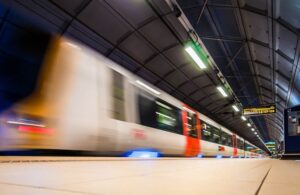SHP hears from SOCOTEC on the impact of an ‘overlooked’ area of safety – slips, trips and falls occurring in the rail industry.
In the fast-paced world of rail transportation, safety is paramount. The challenges are many, from ensuring on-time departures to maintaining tracks and stations.
However, one often overlooked yet significant safety concern in the rail industry is the occurrence of slips, trips, and falls. These seemingly minor incidents can have far-reaching consequences for the workforce, the public and the efficiency of rail operations.
The effect of slips, trips, and falls
 Slips, trips, and falls might sound like everyday occurrences, but within the rail industry, they can trigger a chain reaction of problems. Whether it’s a passenger slipping on a platform, a staff member tripping on uneven flooring, or a contractor falling while maintaining equipment, the consequences can be severe.
Slips, trips, and falls might sound like everyday occurrences, but within the rail industry, they can trigger a chain reaction of problems. Whether it’s a passenger slipping on a platform, a staff member tripping on uneven flooring, or a contractor falling while maintaining equipment, the consequences can be severe.
Human toll
Slips, trips, and falls can lead to injuries ranging from minor sprains to more serious fractures or head injuries. Each incident not only affects the individual involved but also their colleagues, family, and the overall morale of the workforce.
Operational disruptions
Even a brief halt in rail operations can have a cascading effect on schedules and customer satisfaction. If a worker or member of the public is injured, investigations and medical attention can disrupt regular activities.
Financial impact
In addition to potential compensation costs, slips, trips, and falls can result in legal liabilities, increased insurance premiums, and potential compensation claims. These financial repercussions can strain resources that would be better utilised for other safety improvements.
Public perception
Safety incidents reflect poorly on the rail industry’s reputation. A high-profile slip or fall can erode public trust and deter potential passengers from choosing rail as their mode of transport.
To address the issue effectively, it’s essential to understand the risk factors that contribute to slips, trips, and falls in the rail environment:
- Weather Conditions: Rain, snow, ice, and even leaves on the tracks can create slippery surfaces, increasing the chances of accidents.
- Platform Design: Poorly maintained platforms, uneven flooring, and inadequate lighting can create hazards for both passengers and staff.
- Maintenance Areas: Work areas, maintenance pits, and equipment can become slippery due to oil, grease, and other substances.
- Human Factors: Fatigue, improper footwear, and distractions can heighten the risk of slips, trips, and falls.
Slips, trips, and falls might seem minor, but their impact on the rail industry is far from insignificant.
How can SOCOTEC UK help?
As a provider of testing, inspection, and certification services, SOCOTEC UK is dedicated to enhancing safety across various industries, including rail by:
- Comprehensive Site Assessments: SOCOTEC’s professionals conduct thorough site assessments to identify potential hazards, from platform conditions to maintenance areas.
- Surface Testing: We offer slip resistance testing in line with European Standard EN 13036-4:2011, to ensure that platform, concourse and other surfaces such as those in workshops etc meet safety standards, even in challenging weather conditions.
- Training and Awareness: SOCOTEC provides training programmes to educate rail personnel about risk factors, prevention measures, and best practices.
- Ongoing Monitoring: Regular monitoring and assessments ensure that safety measures are continuously effective and that potential hazards are promptly addressed.
This eBook will guide you through some of the key understandings you need to be able to manage driver safety effectively and, at the end, provide a series of free resources you can access to help you ensure your own driver safety management system is robust, legally compliant and in line with industry-accepted good practice.
Download this eBook from Driving for Better Business and SHP to cover:
- Why do we need to manage driver safety?
- Duty of care – a shared responsibility;
- Setting the rules with a driving for work policy;
- Managing driver safety;
- Ensuring safe vehicles;
- Safe journeys and fitness to drive;
- Record keeping;
- Reporting;
- The business benefits of good practice;
- Additional resources

 Slips, trips, and falls might sound like everyday occurrences, but within the rail industry, they can trigger a chain reaction of problems. Whether it’s a passenger slipping on a platform, a staff member tripping on uneven flooring, or a contractor falling while maintaining equipment, the consequences can be severe.
Slips, trips, and falls might sound like everyday occurrences, but within the rail industry, they can trigger a chain reaction of problems. Whether it’s a passenger slipping on a platform, a staff member tripping on uneven flooring, or a contractor falling while maintaining equipment, the consequences can be severe.